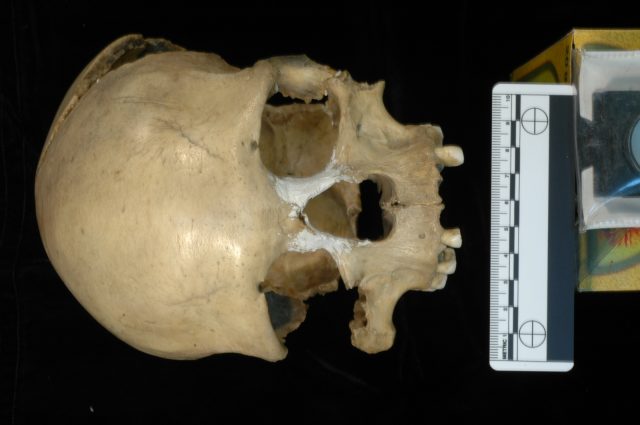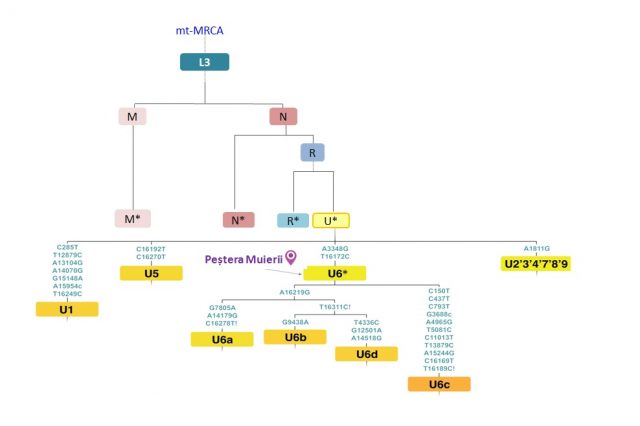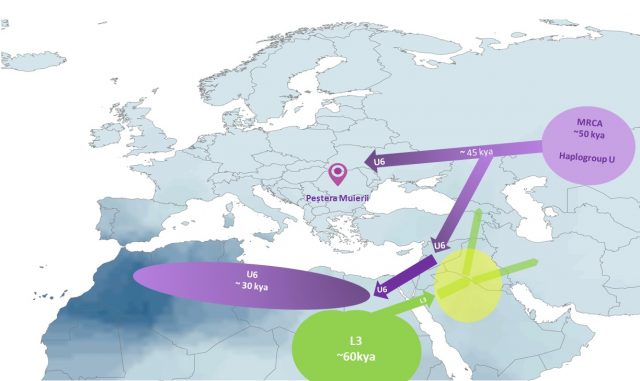Evolution: A Palaeolithic back migration to Africa
Authors:
M. Hervella & C. de la Rúa do research and teach at the Genetics, Physical Anthropology and Animal Physiology Department of the University of the Basque Country (UPV/EHU).
After the dispersal Out of Africa of modern humans, around 50–70 thousand calendar years before present (ky cal BP for short) 1 or earlier based on fossil evidence2, hominins with similar morphology to present-day humans appeared in Western Eurasia around 45–40 ky cal BP, initiating the demographic transition from ancient human occupation to modern human expansion into Eurasia.

Population genetic analyses of present-day humans suggest that in conjunction with the Eurasian expansion, some populations initiated a back-migration to North Africa3. However, the scarcity of Upper Paleolithic human fossils in North Africa has prevented researchers from obtaining direct evidence of such a migratory phenomenon.
In this context, the Scientific Report paper published by Hervella et al.4 presents the mitochondrial genome (mitogenome) of the Peştera Muierii 1 (PM1) remains from Romania (Figure 1), directly dated to 35 ky cal BP, which sheds new light on the Early Upper Paleolithic (EUP) migrations in Eurasia and North Africa.
Paleogenomics technology allowed reconstructing the complete mitochondrial genome from the DNA recovered from two teeth from PM1 fossil. The reconstructed genome was compared with other ancient mitogenomes coming from Denisovans, Neanderthals, and Upper Paleolithic Homo sapiens. Producing as a result that PM1 female is identified as Homo sapiens, although she exhibits some morphological features related to Neandertals. Besides, the mitogenome of this human belongs to the U clade which derived from the macro-haplogroup N, connected to a human migration Out of Africa that took place around 60-70 ky BP carrying L3 mitochondrial lineage (Figure 2).

A detailed analysis of the nucleotide mutations in the PM1 mitogenome identified as a basal haplogroup U6* which has not previously been identified in any ancient or present-day humans. The U6 haplogroup is the only sub-haplogroup within the U clade currently present in Africa. The U6 haplotypes found in nowadays in Europe have been attributed to African sources, mainly to the historic Moorish expansion.
The mitogenome U6* corresponds to the most ancient population from which all descendants belonging to this haplogroup (U6a, U6b, U6c…) derived (Figure 2). The findings confirm that U6 mitochondrial lineage has a Eurasian origin, supporting the hypothesis of an early back-migration from Eurasia to North Africa, starting approximately from 45.000, in the Early Upper Paleolithic.
The authors propose that the newly identified U6* mitogenome is the basal haplogroup from which haplotypes found in present-day Northern African populations are derived. This research suggests that the PM1 lineage could be an offshoot to South-East Europe of the Early Upper Paleolithic migration that leads U6 from Western Asia to Africa during which it diversified until the emergence of the present-day U6 African lineages.
This paper together with other recent paleogenomics data show that the evolutionary history of Homo sapiens was more complex than it was thought from the “Out of Africa” hypothesis (Figure 3).

References
- C. Posth, G. Renaud, A. Mittnik, D. G. Drucker, H. Rougier, C. Cupillard et al. Pleistocene mitochondrial genomes suggest a single major dispersal of Non-Africans and a Late Glacial Population turnover in Europe. Current Biology 26, 827–833 (2016). ↩
- W. Liu, M. Martinón-Torres, Y.J. Cai, S. Xing, H.W. Tong, S.W. Pei, M. J. Sier, X. H. Wu, R. L. Edwards, H. Cheng, Y.Y. Li, X.X. Yang, J.M. de Castro, X.J. Wu. The earliest unequivocally modern humans in southern China. Nature 526, 696-700 (2015). ↩
- [B. Secher, R. Fregel, J.M. Larruga, V.M. Cabrera, P. Endicott, J.J. Pestano, A. M. González. The history of the North African mitochondrial DNA haplogroup U6 gene flow into the African, Eurasian and American continents. BMC Evolutionary Biology 14,109 (2014). ↩
- M. Hervella, E. M. Svensson, A. Alberdi, T. Günther, N. Izagirre, A. R. Munters, S. Alonso, M. Ioana, F. Ridiche, A. Soficaru, M. Jakobsson, M. G. Netea, C. de-la-Rua. The mitogenome of a 35,000-year-old Homo sapiens from Europe supports a Palaeolithic back-migration to Africa. Scientific Reports 6, 25501 (2016) DOI: 10.1038/srep25501. ↩
3 comments
[…] A todos nos suena, o nos debería sonar, que la especie a la que pertenecemos evolucionó en África y que salió de ella. Aunque algunos miembros volvieron en el Paleolítico. Montse Hervella y Conchi de la Rúa en Evolution: […]
[…] Evolution: A Palaeolithic back migration to Africa […]
[…] Eurasia to North Africa, starting approximately from 45.000, in the Early Upper Paleolithic.” ref […]